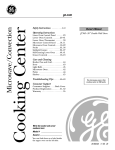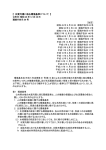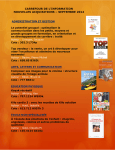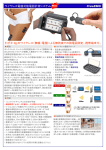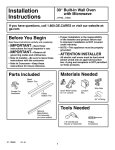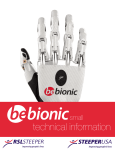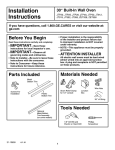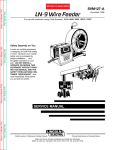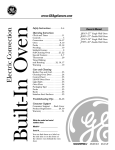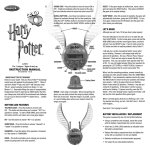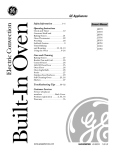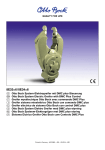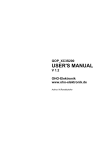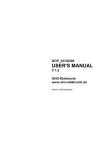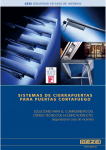Download Document
Transcript
Revised July 2001 Dear Prosthetist, Welcome to Motion Control's "Third Party Funding Guidelines." We have developed the enclosed information to share past experience with you, and help you in receiving funding for the Utah Arm, ProControl 2 System and ServoPro Controller. Please remember that this information is based on samples only and each case should be customized to meet the patient's need. If you have any further questions, feel free to contact Motion Control's customer service department and we will be happy to answer them. In addition, suggestions for ways to improve this information are always welcome. Call or send us an email at [email protected]. Contents: I. Guidelines for Third Party Funding - A step by step outline of the procedures you can follow when applying. II. Sample Letter - Utah Artificial Arm/ServoPro - A sample format to use when writing to a third party funding agency. III. Pricing Estimates - Utah Arm/ServoPro/ProControl - Guidelines for estimating the costs of a myoelectric system. IV. L-Codes - A list of L-codes to use for billing, along with current (Utah) Medicare reimbursement. Actual reimbursement in your state may differ. Motion Control, Inc., a division of Fillauer, Inc. 2401 South 1070 West, Suite B; Salt Lake City, UT 84119 Ph- (801) 978.2622, or toll free at (888) 696.2767; Fax- (801) 978.0848 Website: www.UtahArm.com E-mail: [email protected] Page 1 GUIDELINES FOR THIRD PARTY FUNDING Contents: • Introduction • 1. Overview: How to Obtain Preauthorization • 2. Steps to Take After Submitting PreAuthorization • 3. Justification of a Myoelectric Powered Prosthesis: Summary of Benefits • 4. Impact on Actual Tasks the Wearer Performs in His/Her Daily Life • 5. Comparisons with Alternative Products • Otto Bock • Boston Elbow • Hosmer Elbow • Other Key Features of the Utah Arm Introduction This paper is intended to give you the information to make a strong case for an appropriate Utah Arm or ProControl candidate. Refer also to the accompanying Model Letter, for help in composing an effective letter of justification. If we can supply any further information, please feel free to call or write us at the address at the front of this document. Insurance funding of a Utah Artificial Arm prosthesis can, and has been, obtained in hundreds of cases. Nearly all of 800 Utah Arm prostheses fitted have received third party funding. However, it should be anticipated that insurance providers will want to carefully evaluate this benefit, and will expect a well-documented proposal. Initial and long-term costs of myoelectric prostheses are higher than traditional, body-powered arms. Many insurance companies' personnel are not familiar with newer technology; because of this, part of applying for preauthorization is educating the provider about the benefits of myoelectric prostheses. Proper strategy is important in a pre-authorization request. To avoid delays and increase the likelihood of a favorable reply, prepare all materials which justify the claim beforehand. Try to anticipate possible questions. Once submitted, follow-up to make sure the request does not get "lost in the system." 1. How to Obtain Preauthorization: An Overview A. Evaluate the Candidate. The Utah Arm candidate should be evaluated by a knowledgeable certified prosthetist experienced with myoelectric prostheses, and a doctor or clinic familiar with modern prosthetics. If a referral is needed, call Motion Control for a list of authorized centers (other certified prosthetist can become qualified by attending a training course offered by Motion Control.) B. Obtain Prescription. A prescription must be obtained from a physician for a "myoelectric elbow and hand (wrist and Griefer, if appropriate) prosthesis, Utah Artificial Arm type." Your physician should also write a letter of justification (as described in Section 3), stressing that this prosthesis is "medically necessary." Page 2 C. Letter of Justification. A letter of justification must be written to explain the medically necessary rehabilitation benefits of the planned prosthetic care. The prescribing physician should write the letter. The prosthetist may provide additional information. We advise that the benefits of the myoelectric prosthesis be related to the patient's work and personal needs as specifically as possible. See Section 4 below for a summary of such benefits. D. Prepare Estimate. A complete quotation for delivery of the prosthesis should be prepared by the fitting center. The quotation should describe the purpose of all components to be delivered. Training, follow-up, extended warranty, and any other services should be estimated for the insurance company at this time. 2. Steps To Take After Submitting For Pre-authorization. A. Follow Up. Contact the insurance company's claims office if a reply is not received within two weeks. Ask when a decision can be expected (many states require insurance companies to respond within 30 days). Record the date of inquiry and the person with whom you spoke. If the company promises authorization, or makes any other commitments or denials, ask for written confirmation. Be patient, and offer to provide any needed information. B. Persevere. If the claim is denied, don't give up! Remember this is only their first response not necessarily their last. Request a written response, detailing the reasons for denial. You will then have something specific to answer. C. Answer Objections. Inform the physician and prosthetist should you receive a denial. The physician should write a response, using the information in this paper, to negate their objections. Motion Control can also 1,2 supply reprints of articles from medical journals documenting the benefits of myoelectric prostheses. If, for instance, a claim for a Utah Artificial Arm is rejected as "experimental," their objection can be refuted by citing experience with over 1,400 fittings since 1981. Send an appeal to the claims manager (or the insurance companies' specified contact), with a copy of the original claim. Then call to make certain it was received. Ask about appeal procedures and the time involved. The appeal will probably be passed to a "medical reviewer" or committee. Be sure this review is conducted with all available information on hand. If the first appeal is denied, ask again for the denial in writing. Also, inquire whether another appeal is possible, to a higher level person or committee. Should you be denied again, then answer (or ask the physician to answer) all objections and resubmit. Be patient and persistent. Many claims have been authorized after two or more appeals. D. Lodge a Complaint if necessary. If the claim has not been given fair consideration, then lodge a complaint with the state insurance commission (sometimes known as the Department of Insurance). Call their consumer information office and ask for advice about filing a complaint. In some states, you may be able to request an "insurance hearing" from the state commission, to help settle the appeal. If all else fails, and you have a legitimate claim, it may become necessary to get an attorney's advice (the possibility of legal action may be enough to convince the insurance company to pay the claim.) Page 3 3. Justification of a Myoelectric Powered Prosthesis - Summary of Benefits. Physicians, prosthetists, or others writing a letter of justification are advised to study the following benefits. Those which are appropriate to the specific patient should be stressed to the funding agency. A. Hand Prehension: Motorized (powered) hand drive allows greater pinch force up to 22lbs force (1 kg). Since a motor drives the hand, it has the benefits of both voluntary-opening and voluntary-closing, i.e., the wearer controls the direction and the amount of opening and closing. Body-powered hands do not allow a user good control of the opening and closing force without significant effort. Myoelectric control also allows a wearer to maintain hard or light grip, without effort, e.g., when holding an object for a period of time. For heavy work situations, the myoelectric hand is interchangeable with an electric hook terminal device. This allows the patient to have a "public" hand and a "work" hand, to allow function in almost any situation. The electric hook has the possibility of an even greater pinch force of up to 36 lbs. Since power to the hand is controlled by the amount of the amputee's muscle contraction, 4 proportional control allows moderation of pinch force and the handling of fragile objects. Speed of opening and closing is also controllable. Sensitivity of the hand control components for the ProControl (below-elbow) and the Utah Arm (above-elbow) allow operation with just five microvolts of surface EMG, significantly less than other myoelectric systems. This means less effort to operate the hand. A myoelectric prosthesis unusually permits a greater work envelope for the wearer by eliminating the control cables. Since cables need not be pulled across the back, the hand may be opened and closed above the head, at floor level and even behind the back. These are very important comfort and functional benefits over body-powered arms. B. Flexion/Extension of the Elbow: Above-elbow, shoulder disarticulation and forequarter amputees can flex and extend the elbow of the Utah Artificial Arm though-out a range of 15 to 150 degrees. Motorized drive means that elbow motion is achievable without fatiguing muscle effort or movement of other body joints. C. Comfort: Comfort is also increased when cables are eliminated. The pull of a body-powered arm's control cable creates axillary forces in the contralateral arm. It can also cause skin irritation and nerve 3 damage. Myoelectric candidates with sufficient residual limb length are often fitted with selfsuspending (suction) sockets. Amputees consider these sockets to be more comfortable because they eliminate or at least reduce harness loads. It must be emphasized that the comfort of the socket has a direct impact on function. If the prosthesis is rejected, or worn infrequently, because of discomfort, then it is non-functional. D. Freeswing. The Utah Artificial Arm incorporates a feature known as freeswing. The elbow swings freely whenever the wearer relaxes the control muscles. Perhaps more importantly, freeswing is used to extend the elbow without effort. Also, because reaction forces at the shoulder and socket are lessened, the prosthesis is easier to wear while walking. Page 4 4. Impact On The Actual Tasks The Wearer Performs In Daily Life A. Below-Elbow Amputees: 1. Increased functionality. The letter for pre-authorization should mention specific duties which the amputee may be expected to perform that could be enhanced by a myoelectric prosthesis. Two-handed activities such as handling papers, holding a telephone while dialing, and carrying papers or briefcases in a normal fashion, are all a common office and school tasks. In the wearer's workplace tools may be used which require two hands. If the patient is a candidate for electric wrist rotation, specific situations may exist where using the sound hand to passively rotate the wrist would be awkward or impossible. For bilateral amputees, or unilateral amputees whose remaining hand is not fully functional, or for those in danger of damaging the remaining arm, a strong case can be made for providing every available prosthetic function. 2. Broader range of Occupations. The range of occupations may also be broadened for an amputee who chooses a myoelectric prosthesis. For instance, wearing a myoelectric hand, rather than a body-powered hook may significantly enhance the move from blue-collar to white collar occupations. 3. Increased work envelope. Usually the comfort of a myoelectric prosthesis allows a longer wearing period per day. Since there are no restrictions from a body-powered cable, the work envelope may be increased, permitting specific tasks to be performed. 4. Cosmetic benefits. The cosmetic benefits of a myoelectric prosthesis should not be described as merely a "nicerlooking" alternative. The more natural appearance lessens the psychological trauma and aids the process of adjustment. These are medically necessary benefits, not merely cosmetic frills. It must be remembered that often the attitudes of the amputee's family greatly affect the adjustment process. The family may be more supportive of a natural-looking hand than of a less cosmetic prosthesis. B. Above-Elbow Amputees: Most of the benefits mentioned above for below-elbow amputees also apply to above-elbow patients. Additionally, other considerations exist which will be important to above-elbow amputees. 1. Function with elbow flexed. At the fully-flexed position of the elbow, complete function of the hand (or Greifer) is available which is of great benefit to the high-level amputee. [A body-powered prosthesis typically does not allow full opening of the terminal device (hand or hook) when the elbow is flexed above 90 degrees.] Therefore, a myoelectric prosthesis permits more function when the elbow is flexed. For example, a patient can operate equipment at eye level like a camera or microscope, or grasp food and bring it to the mouth better with a myoelectric arm. 2. Prevention of nerve damage. Above-elbow amputees who actively use a body-powered prosthesis are susceptible to nerve 4 damage on their contralateral side. This is caused by pressure from the harness and control cable. A myoelectric prosthesis can prevent damage from developing, or relieve it once it has occurred. C. Shoulder Disarticulation, Forequarter, and Brachial Plexus-Injured Amputees: Page 5 This segment of the unilateral amputee population has lost the most function, and thus needs the most restored. Body-powered prostheses are often difficult, uncomfortable, and sometimes impossible for amputees of this level to operate. The advantages of myoelectric prostheses for above and below-elbow cases (stated above) are not only applicable, but of even greater importance, for these high-level amputees. Function of the terminal device at elbow positions above 90 degrees (very difficult with body-powered arms) is even more important. Because of the extensive loss suffered by these amputees, it is difficult, even with a myoelectric prosthesis, to regain all function. However, there are many examples of successful everyday prosthesis users among this group. Trial fittings can help verify the prescription, or guide the clinical team to the optimal prescription. D. ServoPro Option: A feature exclusive to the Utah Arm, called ServoPro, insures that even the highest level amputee can operate the Arm. Designed for the very high-level amputee, e.g., shoulder disarticulation, interscapulothorasic, or brachial plexus injuries, the ServoPro option completely eliminates the electrodes normally required for myoelectric prostheses. A very slight pull on a simple harness is all that is needed to control the Utah Arm system. For difficult cases, the ServoPro controller may be the only option available which can provide functional control of both elbow and hand. Relative to body-powered cables, the excursion and harness force required for ServoPro control is far lower, and thus the prosthesis is much more comfortable. Compared with harness-mounted switches for other electric elbows, ServoPro control provides much more functional control because of the proportionality, and sensitivity of the controller. That is, the ServoPro wearer can control the elbow position, and the hand force with much better precision than switch control can provide. 5. Comparisons With Alternative Components. The prosthetist and/or physician may wish to present the pros and cons of various options available for a specific patient. Following are the key differences between Motion Control components and most alternatives. These features of the Utah Arm are especially relevant for high level amputees: • • • Muscle signals are typically weaker with high level patients, requiring maximum sensitivity from the electronics in the prosthesis. Since hand function is usually of highest priority, a sensitive, easily-operated hand is especially important This is available with a Utah Arm. When muscle (myoelectric) control is not feasible, cable excursion is very limited, so controlling the Utah Arm's elbow and hand from only one harness-mounted sensor, (i.e., the ServoPro controller) simplifies the harnessing of a high-level prosthesis greatly. No other system can operate elbow flexion and extension, hand open and close, as well as the transfer of function between them, all from a single easily-controlled sensor in the harness. A comparable Boston Elbow fitting would require 3 to 5 control sites (depending upon whether switch, myoelectric, or touch pad control is utilized) for elbow, hand and switching between elbow and hand. Suspension of a heavy prosthesis also becomes more difficult with high level amputees, i.e., HEAVIER PROSTHESIS + MORE DISTAL WEIGHT = MORE DIFFICULT SUSPENSION. The freeswing feature of the Utah Arm is especially important for these amputees, allowing them to extend the elbow by simply relaxing, which is not possible with any other electric elbow. Page 6 A. Otto Bock Below-Elbow Prosthesis: 1. The Utah Arm has proportional control. The Otto bock Orthopedic Industry manufactures a "digital" electronic controller, and a "DMC" (Dual Mode Control) proportional controller. "Digital" control indicates that the hand is either on or off, with no gradation of speed. Naturally, proportional control allows better control of speed and force than a digital controller, as demonstrated in surveys of actual wearers. 2. The ProControl is more sensitive. The Otto Bock digital control is less sensitive than the ProControl, and sometimes cannot be operated by patients with weaker muscles. Even in the best case, greater effort can be expected with the digital controller than for the ProControl or the Utah Arm. The hand will usually not run as quickly, since it operates only on a 6-volt battery pack, as opposed to 12 volts in the Utah Arm, and 7.2-14.4 volts in the ProControl system. 3. The ProControl is quicker with less effort. Otto Bock also makes a Dual Mode Control (DMC) proportional hand. The DMC hand operates only on a 6-volt battery, so its speed, again, is not as quick as the ProControl system, operated with batteries ranging from 7.2 to 14.4 volts. Also, the ProControl is capable of operating with a lower threshold of muscle contraction, so the wearer's effort is lower. 4. More natural muscle control. There are some other very basic, but important, differences in the control of the Utah Arm and ProControl systems, compared with the Otto Bock systems. First, the Utah systems are operated by the difference between the two control signals, much like natural muscles operate. This approach provides very delicate and precise control over the hand motion, taking advantage of the natural synergy of agonist-antagonist muscle pairs. If one muscle is stronger than the other, adjustments in the Utah Arm and ProControl allow the two muscles to be balanced very precisely, so the operation of the hand or elbow is also balanced in both directions. 5. Utah Arms can be fine-tuned to the patient. A second key difference, is the adjustability of the Utah Arm and ProControl systems which allow the system to be "fine-tuned" to the patient. In addition to the sensitivity adjustments for both balance and overall sensitivity of the hand, the prosthetist can also adjust the threshold of operation of the hand (in both Utah Arm and ProControl). This is important so that the prosthetist can raise the threshold to eliminate unwanted motion of the hand from "jittery" muscles. For example, many patients' muscles tend to contract together, especially at low levels of muscle tension. In the ProControl and Utah Arm, the prosthetist can simply raise the threshold of operation of the hand, so the hand does not move unless the wearer intentionally generates a signal. 6. Proportional control of hand and wrist. The combination of a proportionally controlled hand and wrist, in a below elbow prosthesis, is also unique to the Utah ProControl System. The function of electric wrist is now much more widely used because of the ease of operation in the ProControl system. A survey of ProControl wearers using the electric wrist has shown that for those who wish to extend their function to the maximum, the electric wrist is one of the most useful features of their prosthesis. For example, they use it for prepositioning their hand prosthesis, even when their other hand (or prosthesis) is occupied carrying objects, or for steering a car. 7. Interchangeable batteries. Another convenient feature offered by the ProControl which the Otto Bock system does not: the ability to interchange between a rechargeable battery and a convenient nine-volt battery. This allows a ProControl wearer not only to use rechargeable batteries at home or work, but also to use a 9-volt battery, available at any store selling batteries, when traveling, Page 7 or camping, etc., where a recharger is inconvenient. The 9-volt battery also operates the hand faster, which is another benefit available only with the ProControl. B. Boston Elbow: The Boston Elbow, introduced in 1973, was developed by the Liberty Mutual insurance company. The most recent version is called the Boston Elbow II. The improvements implemented in the Utah Arm 2 will not only give a performance edge over the Boston Elbow, but by using more up-to-date manufacturing in the electronics and connectors throughout the arm, the Utah Arm 2 is a much more dependable choice. 1. Distal Weight Distribution. The Boston Elbow is a few ounces heavier than the Utah Arm, but because the battery pack is installed in the forearm, it has a heavier distal weight distribution, i.e., it feels significantly heavier to the wearer. All prosthetic candidates should be evaluated carefully for weight tolerance, regardless of the components. For a small individual, or someone especially sensitive to prosthetic weight, this criteria could override all others, making the prosthesis too difficult to actually use regularly. 2. Requires additional switch for myoelectric control of hand. The Boston Elbow II is capable of switch operation, myoelectric control, or touch pads installed inside the socket. Myoelectric hand control is possible, but requires an additional switch in the socket or harness to cause the transfer of function from elbow to hand. 3. Requires more effort. Since the Boston Elbow does not extend automatically in freeswing like the Utah Arm, both muscle signals must be well-controlled independently for the wearer to achieve good control over both elbow flexion and extension. The freeswing feature of the Utah Arm, which uses "relax to extend," can mean a great deal less effort for a wearer, which may translate into more comfort and longer wearing times. 4. Higher threshold. Another advantage with the Utah Arm is that the threshold for hand control (only 5 microvolts) is the lowest of any available componentry. For maximum flexibility in fitting, the prosthetist can also adjust the threshold for each control muscle independently, as well as its sensitivity. 5. Nonmodular. 5 Modular construction, pioneered in the Utah Arm, is not available in the Boston Elbow. Modularity allows rapid field service when needed, even allowing the same arm socket to be used with both a body-powered elbow, as well as the Utah Arm when desired. Although others have attempted to mimic the Utah Arm's replaceable battery pack, batteries are not as easily interchanged by the wearer in the Boston Arm or the Hosmer Elbow (see below). C. Hosmer Elbow: The Hosmer (also called the NYU) Elbow is available with either switch or myoelectric control, however, with myoelectric elbow control, the muscles cannot be used to control the hand. The Hosmer Elbow is light, but with a myoelectric hand installed, the elbow speed is significantly slower than the Utah elbow. The Hosmer Elbow, unlike the Utah Arm, is not designed so that the battery can be easily interchanged by the wearer, although there are various battery packs available. Freeswing is only possible with the elbow extended, so the convenience of "relax to extend" is not available. For high Page 8 level amputees, the Homer elbow typically needs to be switch-operated, giving only one speed operation. D. Other features of the Utah Arm: Motion Control is the leading U.S. manufacturer of myoelectric components. We offer the highest level of service to fitting centers and prosthetic users. For added benefit, we offer three unique programs: 1. Trial Fitting. Motion Control will rent components to qualified prosthetic centers. This permits a "difficult-to-fit" patient to field-test a prosthesis, at a fraction of the cost of a definitive arm (consult the chosen fitting center for details.). 2. Two-Year Warranty. Motion Control is the only manufacturer of prosthetic arm components to offer a two-year warranty. Consumers can have confidence that Motion Control backs up its products. Our commitment to rapid service, when repairs are necessary, means minimal downtime for the wearer. 3. Extended Warranty Option. Beyond the initial time period, Motion Control offers an optional two years of extended service. This plan may be purchased any time within the initial warranty period. References 1. Kritter, Alfred E.: Current Concepts Review: Myoelectric Prostheses. The Journal of Bone & Joint Surgery, Vol. 67-A, No. 4: 654- 657, 1985. 2. Millstein, G., Heger, H., and Hunter, G.A.: Prosthetic use in upper limb amputees: a comparison of the body powered and electrically powered prostheses. Prosthetic & Orthotic International, 10: 27-34, 1986. 3. Reddy, M.P.: Nerve Entrapment Syndromes in the Upper Extremity Contralateral to Amputation. Arch Phys Med Rehabil Vol. 65, 24-26, 1984. 4. Sears, Harold H. and Shaperman, Julie: Proportional Myoelectric Hand Control: An Evaluation. Amer. Journal Phys. Med. Rehabil., Vol. 70, No. 1, Feb. 1991. 5. Jacobsen, S.C., Knutti, D.F., Johnson R.T., and Sears, H.H.: Development of the Utah Artificial Arm. IEEE Trans. on Biomedical Engineering, Vol. BME-29, No. 4, April 1982. Page 9 SAMPLE LETTER Third-Party Funding Letter for Utah Arm Candidate [Changes in specific language for ServoPro- controlled Utah Arm are included in italices ] BlueCross/Blue Shield of Utah 1234 State St. Salt Lake City, UT 84123 Re: Mr. Robert G. Soc. Sec. #555-33-1234 Your case#: A007 Dear Mr. Chuck In-Charge; Purpose of letter We are writing to explain the results of our prosthetic evaluation of Mr. G., and our recommendations for his prosthetic rehabilitation. Patient history Mr. G. was seen in our office on Jan. 1, 1995. He suffered a left above elbow (transhumeral) amputation, after a severe electrical accident at his ranch, in April 1994. He is very motivated to return to work on his ranch and to achieve the maximum function he is able to with a prosthesis. He has been active in many recreational and social activities and wishes to return to those to the greatest extent possible. Especially important to him are square dancing and woodworking. Mr. G. is unmarried at this time. Mr. G.presented with scar tissue covering the end of his remnant limb and left axilla region. He remains very tender in that area and cannot tolerate pressure for longer than a few seconds. Also, due to the scarring, his shoulder range of motion appears to be restricted to 20 degrees of flexion, and 20 degrees of abduction. In addition to the examination of Mr. G.’s skin and shoulder conditions, we also performed an EMG evaluation of the remnant muscles in his arm and shoulder. We found a moderate EMG (maximum 25 microvolts, using the Myolab II EMG tester/trainer) can be produced by contraction of his biceps muscle. This muscle also fatigues after approximately five minutes of training, and becomes weaker and more uncomfortable to contract. The triceps EMG signal is also only moderately strong (maximum 35 microvolts), but did not fatigue in ten minutes of training. With regular biofeedback training, performed by a qualified therapist, we are optimistic that more muscle strength can be regained. [ServoPro Candidate: We found that only a very low level of EMG (maximum 5 microvolts, using the Myolab II EMG tester/trainer) can be produced by contraction of his biceps muscle. Contraction of this muscle is also very painful for Mr.G. Therefore we feel his Page 10 maximum potential can only be attained with a harness-mounted,controller with an externally-powered prosthesis.] Page 11 Recommendation For the above reasons, Mr. G. will not be able to operate a body-powered prosthesis as successfully as an externally-powered prosthesis. We recommend an externally-powered above-elbow prosthesis, specifically, a Utah Arm 2, including an electric hand, a Hosmer Synergetic Prehensor (or/ Greifer) heavy-duty terminal device and an electric wrist rotator. [We recommend a servo -controlled above-elbow prosthesis, specifically, ...] To protect the delicate electronics, a silicone protective hand and forearm cover is proposed. The cover will enhance the natural appearance of the prosthesis and contribute to Mr. G.’s willingness to wear the prosthesis in public, without feeling conspicuous, in business and social occasions. The psychological adaptation to limb loss, and use of a prosthesis, is enhanced with a natural-looking prosthesis. We feel this is true in Mr. G’s situation. If and when Mr. G.’s physical condition allows it, we also recommend a body-powered aboveelbow prosthesis, with a hook-type terminal device, as a back-up to the externally-powered prosthesis for wet working conditions, and especially dusty and dirty environments where dirt could get into the elbow and/or hand drive. Justification The functions which Mr. G. is expected to attain with the Utah Arm prosthesis include excellent control over the opening and closing of the hand. Mr. G. should be able to begin using the prosthesis right away. The gripping force of the hand, controlled by the Utah Arm, has the most sensitive proportional myoelectric control available (minimum required EMG signal is 5 microvolts). [With the ServoPro Controller, Mr. G. will have full gripping force of the hand with only a very slight pull on the harness.] The Synergetic Prehensor (or/Greifer) heavy-duty “work hand" provides increased grip force, and a wider opening. These features will prove more adaptable to handling work tools. Additionally, it allows him to use the prosthesis in situations where the hand cover could be ripped or stained. He would then interchange the hand for the Synergetic Prehensor (or/Greifer) when repairing fences, or shoveling, which are common activities for him. As stated earlier, his ability to operate a body-powered prosthesis is severely restricted, due to remaining scar tissue. The externally-powered elbow of the Utah Arm will be important to Mr. G., since positioning will not require the physical motion of his shoulder. Therefore, it will provide function of the elbow without discomfort to his remnant limb and axilla area scarring. The electric wrist rotation feature will also be useful in his active work situations. It is used to position the hand or Greifer in the best gripping position, without requiring his sound hand to turn the hand. Using his sound hand would be awkward or impossible during two-handed tasks such as carrying boards, using hand tools, holding wires or papers to cut with shears, etc. All these components are medically necessary for the maximum rehabilitation of this very motivated individual. Extensive occupational and physical therapy is essential to a patient's prosthetic success. Our center is unique in that we provide prosthetic rehabillitation, not just a prosthetic device. Occupational therapists associated with our center will provide three weeks of muscle training before fitting, and training will continue during and after the fitting. Our Page 12 therapists will also provide functional use training during fitting, and post-fitting as well, so that proper use patterns are established. We have found that this type of training not only increases the functionality of the patient with the prosthesis, but helps to identify any early problems with control, and/or fit, during the important early stages of fitting. Background We have fitted over 20 patients with the Utah Artificial Arm, with very good results. Experience we have gained in fitting externally-powered prostheses, and careful selection of good candidates for these prostheses, have taught us that the advantages far outweigh any disadvantages. For Mr. G. specifically, the combination of function, comfort, appearance and reliability will produce the best prosthetic rehabilitation which can be provided for this patient, given his needs and medical condition. The Utah Arm has been successfully fitted to over 1400 patients to date. It has shown very good reliability and durability and we feel it will be the best choice for Mr. G. In fact, we anticipate considerable problems with fitting any other type of prosthesis for Mr. G. Others will limit his function and decrease his comfort, thus increasing the chance of rejection considerably. Documentation, etc. I am enclosing a copy of the prescription by Dr. Knows-His-Stuff for Mr. G’s prosthesis, specifying a myoelectric Utah Artificial Arm. A copy of Dr. Knows-His-Stuff ’s letter concerning this prescription is enclosed. Also, a reprint of the chapter concerning the Utah Artificial Arm from the book, Comprehensive Management of the Upper Limb Amputee, edited by Atkins and Meier, is enclosed for your information. (Request copy from Motion Control) Plan of care Once authorization has been received, the plan of treatment for Mr. G. will begin with preprosthetic training. After two weeks, as mentioned earlier, we will fabricate a temporary prosthesis, requiring several check sockets, over a period of two weeks. [Please keep in mind also, that much evidence exists to show that the success of prosthetic fitting is directly related to the promptness of the rehabilitation program after amputation.] Then, initial use training for the prosthesis will begin, concurrent with completion of the temporary fitting. The temporary prosthesis, which is fully as functional as the finished device, will be used for two months to four months. During this time any adjustments to the fit, or fine tuning of the electronics are accomplished. When Mr. G’s remnant limb is fully stabilized (no further volume changes are occuring) and an optimal fit is attained, then the final definitive socket will be fabricated, and the completed prosthesis delivered to Mr. G. After delivery, we will schedule visits with Mr. G. every four months. Follow up will maximize his rehabilitation. Our committment for follow-up after delivery of the prosthesis is two years, without charge for normal maintenance. The manufacturer’s warranty is two years from our Page 13 receipt of the components. Normal warranty follow-up presumes of course, no extraordinary weight changes, and normal use of the prosthesis, within the guidelines in the Utah Artificial Arm User’s Manual. Price of care The price for this complete package of care will be $ , with half the amount paid in advance, to allow us to purchase the componentry. The balance will be payable upon delivery of the definitive prosthesis. * Prosthetist - Please Place Billable L-Code Breakdown Here (see attached sheet to choose correct codes) If desired, we could also structure a “Trial Fit” which guarantees that the prosthesis satisfies everyone’s expectations after a trial period of four months. This would require a 40% payment in advance, with 30% applicable towards purchase, if the trial is successful to the satisfaction of the patient, the clinical staff (including ourselves), and the funding source. This program in effect guarantees satisfaction with the prosthesis, with risk of only a 40% fraction of the potential cost, to pay for our time and rental of the components. In the case of Mr. G., we have so few doubts about his motivation, and his abilities to learn to use this prosthesis, that we do not necessarily recommend this option in this case. Follow up on application We hope to have your written authorization within two weeks, so that we can begin this stage of Mr. G.’s rehabilitation as soon as possible, for his benefit. If there are any further questions, please feel free to contact me directly. Yours truly, Mr./Ms. Able T. Fit , C.P. Director of Prosthetics My-Oh Lectric Limbs-R-Us enclosures Page 14 PRICING ESTIMATES FOR A UTAH ARM OR PROCONTROL SYSTEM The pricing of a prosthesis delivered to a patient involves far more than just the components. In addition, components and services vary from individual to individual and cannot always be predicted, therefore, exact pricing cannot be given before the patient is evaluated. The figures below are intended for use as an estimate only. UTAH ARM 2 COMPONENTS: • • • • • • Proportional Myoelectric Elbow Unit Proportional Myoelectric Hand Control EMG Sensors - i.e., EMG Preamplifiers (2), w/ electrodes Adjustable - Friction Humeral Rotator Battery Packs- Nickel-Metal Hydride (3) Fast Battery Chargers (1) OPTION: • Includes 2-year warranty on Motion Control components • Carrying/Shipping Case equivalent to myoelectric control WRIST ROTATION OPTION: • • Otto Bock Electric Wrist Rotator Chin Switch, Harness Switch or Myoelectric Control Option SERVO PRO CONTROLLER • • Replaces EMG sensors & electrodes with harness-actuated force sensors Operates Elbow, Hand/or Greifer PROCONTROL 2 SYSTEM COMPONENTS: • • • • Hand Version - Includes proportional myoelectric control for hand alone Hand and Wrist Version - Includes proportional myoelectric control of hand and wrist rotation Cosmetic Cover (caucasian or dark color) Electrodes and Wire Harness necessary for installation. Myoelectric Terminal Device Options: Options: Body-Powered Terminal Device [For both Utah Artificial Arm and ProControl System] Any cable-operated Hook • Motion Control Hand - For use with the Utah Arm and ProControl Systems • MYOBOCK Greifer - Special Version for use Adaptor] with the Utah Arm and ProControl Systems • Synergetic Prehensor - Special Version for use with the Utah Arm and ProControl Systems [Interchangeable with the myoelectric hand if used with the Otto Bock quick disconnect PROSTHETIC SERVICES INCLUDE: • • • • • • • • • Prosthetic Evaluation and EMG Evaluation and Training Check Socket Fabrication - Usually includes several versions Check Socket Fitting - Including initial training in use of the prosthesis Fabrication of Definitive Prosthetic Socket and Harness Training in Use of the Prosthesis and its control Fine Tuning of Control Electronics to the Patient Suspension design, fabrication, and modifications (as needed) Follow-up with additional prosthetic care, as needed, for a period of one-year after delivery Use of evaluation equipment (including EMG tester and trainer), and spare parts for immediate service as required, Including back up complete Utah Artificial Arm or ProControl Page 15 OTHER SERVICES - COORDINATED WITH THE FITTING PROCESS: • Physical Therapy for Muscle Training and Development • Occupational Therapy for proper prosthesis operation, donning and doffing, and maximum utilization in ADL's. • Follow up on training and evaluation, as required, for one year GENERAL PRICE GUIDELINES: UTAH ARTIFICIAL ARM WITH MYOELECTRIC HAND [Above-Elbow Prosthesis] Usual Price $45,000 - 55,000 Additional Cost Options: (“Difficult cases,” e.g., shoulder disartic., brachial plexus injury, very short A.E., skin graft, etc.) •Electric Wrist Rotation •Extra Terminal Device (e.g., Greifer, Synergetic Prehensor) •Extended Service Package - 2 year •ServoPro Option •Special Cosmetic Silicone Covers for hand and upper arm +$2,500 - 6,000 +$3,000- 5,000 +$3,000 - 7,000 +$6,000 - 7,000 +$5,000 - 7,000 +$6,000 - 20,000 PROCONTROL SYSTEM [Below-Elbow Prosthesis] • • • • • • Below Elbow Fitting - Myoelectric Hand only Below Elbow Fitting - Myoelectric Hand and Wrist Additional Cost Options: (“Difficult cases,” e.g., Hybrid Systems for above elbow, non-standard fabrication, skin grafts, etc. Extra Terminal Device (e.g., Greifer, Synergetic Prehensor) Extended Service Package- 2 year Special Cosmetic Silicone Covers for hand and forearm. $13,500-22,000 $15,500 -25,000 $1,500 - 6,000 $3,000 - 7,000 $1,300 - 2,200 $4,000 -20,000 EXTENDED SERVICE PACKAGE: As delivered by Motion Control fitting centers, the service contract includes equivalent coverage to the initial 2-year Warranty on Motion Control components, as well as the prosthetic services required to maintain and repair the Motion Control manufactured components of the prosthesis. (Prosthetic services provided may include routine maintenance; troubleshooting; loan of back-up components when required; technician time required in replacement or repair; and shipping as required). Please note that extended service contract coverage does not include repairs for damage incurred outside of normal usage. TRIAL FITTING COSTS: A trial fitting is used to allow the prosthetist to determine the best components for the patient. Initial fitting procedures are performed, the client begins training, and utilizes the prosthesis in daily activities. A trial fitting may last from one to six months and will vary widely depending upon the components used, degree of prosthetic difficulty, and the status of patient prior to the evaluation. Generally, the trial fitting will require a fitting fee plus component rental fees per month, most of which may be applied towards purchase of the prosthesis, should the trial prove successful. Trial fittings can also be useful as proof of suitability for insurance reimbursement. [For further information on the fitting and training procedures recommended by Motion Control, please refer to "Experience with the Utah Arm, Hand, and Terminal Device", Chapter 18 of Comprehensive Management of the Upper Limb Amputee D.J. Atkins and R.H. Meier, ed., Published by Springer-Verlag, New York Inc., 1989.] Motion Control Inc., a subsidiary of Fillauer, Inc. 2401 South 1070 West, Suite B, Salt Lake City UT 84119-1555 www.UtahArm.com Toll-free: 1(888) MYO.ARMS (696.2767) Phone: 1(801) 978.2622 FAX: 1(801) 978.0848 Page 16 RE: Guidelines for Estimated Repair Costs for the Utah Arm and ProControl To Whom It May Concern: These guidelines, coupled with a reasonable inflation estimate, can be used to estimate lifetime costs of an electric arm prosthesis. Please keep in mind however, that arm amputees may have need of other equipment, including other prostheses, batteries, adaptive equipment, etc. Our estimates include only the electric arm prosthesis. • A four to eight year lifetime should be estimated for the arm components, depending upon the extent of usage of the individual arm wearer. • Ten percent of the initial cost of the prosthesis should be estimated for yearly maintenance and repair costs. Though this is rarely needed, we feel it is important to budget for the maximum rather than the minimum. • Additional fittings of new sockets may be necessary, in addition to the replacements and maintenance estimated in #1 and #2 above, because myoelectric prostheses require an intimate fit to function properly. The need for refitting should be estimated by the prosthetist, based upon the patient’s expected weight gain or loss, and other factors such as wear and tear, particularly on the protective covers for the forearm and hand. • New technology may become available for arm prosthesis wearers in the future, but the increase or decrease in cost this may represent is difficult to estimate at this time. For additional information, please contact Motion Control at the address or phone number below. ___________________________________________________________________________________________________ 1070 West 2401 South, Suite B, Salt Lake City, UT 84119-1555 Phone: 888.MYO.ARMS FAX: 801.978.0848 www.UtahArm.com E-mail: [email protected] HCFA L-Codes for the Utah Arm and ProControl System For the Utah Arm 2 (AE and higher levels) Base codes: L6965 L6975 L7180 L7274 L6955 (includes two batteries and one charger) Shoulder Disarticulation with myo control Interscapular-Thoracic with myo control Electronic elbow, Utah myoelectric Proportional control, 12 v utah Above Elbow with myo control Add as appropriate: Battery - 12 volt, utah/equiv [add one for new arm] L7364 L7366 Battery charger - 12 volt utah/equiv L7499 Battery & charger upgrades (from U1 to U2) If ServoPro controller is used: L7499 Unlisted item, ServoPro controller For the ProControl 2: (below elbow or hybrid) Base codes: L6950 L6945 L6935 L6925 L6882 L7274 (includes 2 batteries and one charger) Hybrid, AE Elbow disarticulation, myoelectric Below elbow prosthesis, myoelectric Wrist disarticulation, myoelectric Microprocessor control, upper limb (X1) Proportional control Add as appropriate: L7360 Battery - 6 volt OB or equal L7362 Battery Charger - 6 volt OB or equal L7367 L7368 Suspension, choose as appropriate: L6672 Harness L6682 Test socket - AE or ED L6684 Test socket - SD or FQ L6686 Suction socket L6688 Frame-type socket - AE or ED L6689 Frame-type socket - SD L6690 Frame-type socket - FQ L6680 Test socket - BE & WD L6686 Suction socket L6687 Frame-type socket - BE & WD L6692 Silicone/Gel Liner L8465 Prosthetic shrinker For Roll-on Liners, use: L7499 - similar to LE codes: K0556 (w/lock); K0557 (w/o lock) and L5671 (lock for liner) Wrist and Terminal Devices: L7261 Wrist Rotator, electric L7025 Hand, myo control L7035 Greifer, myo control L7035 M.C. Electric Terminal Device (ETD) suggested upgr. L7499 Water Resistant ETD L6890 Glove(s), production L6895 Glove(s), custom L6629 Quick disconnect for wrist (uncoded item): L7499 Motion Control Flexion Wrist feature (uncoded item): L7499 Short Hand feature Motion Control "ProHand" (controller inside TD) Lithium Ion Battery, 7.2 v replacement Lithium Ion Battery charger suggested upgr. G:/Mktg/3rdpfnd/Lcodes 2003 Rev. 6.6.03 L7025 L7035 L7499 L6882 L7274 Hand, myo control M.C. Electric Terminal Device (ETD) Water Resistant ETD Microprocessor control (X no. of TD's) Proportional control


















